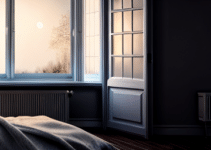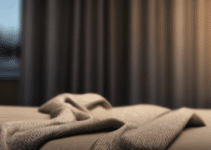Restless leg syndrome is another important factor in improving sleep quality. Make sure your bedroom is cool, dark, and quiet.
Use blackout curtains or an eye mask to block out any light.
Keep noise to a minimum by using earplugs or a white noise machine.
Consider investing in a comfortable mattress and pillows that support your body and help alleviate any discomfort.
Limiting the use of electronic devices before bed is also essential.
The blue light emitted by screens can interfere with your sleep cycle and make it harder to fall asleep. Try to avoid using devices such as smartphones, tablets, or laptops for at least an hour before bedtime.
Instead, engage in relaxing activities such as reading a book, taking a warm bath, or practicing mindfulness or meditation techniques. Restless leg syndrome can cause sleep disruption, making it difficult to get a good night's rest.
Click here for more information. galaxy treats cbd store review
What Causes Restless Leg Syndrome
Restless Leg Syndrome (RLS) is a complex condition with various potential causes, including sleep disturbances and sleep problems. Although the exact reason behind RLS is still unknown, researchers have identified several factors that may contribute to its development.
Genetics play a role, as the disorder tends to run in families, suggesting a genetic link.
An imbalance of dopamine, a neurotransmitter that regulates movement and mood, has also been associated with RLS.
In addition, iron deficiency can impact dopamine production and potentially lead to RLS symptoms. Other factors, such as certain medical conditions, pregnancy, and the use of specific medications, may also contribute to the development of RLS.
Overall, the exact cause of RLS is still subject to ongoing research
Lifestyle Changes for Better Sleep with RLS
Quiet and comfortable surroundings can also aid in improving sleep quality for individuals with RLS, offering effective sleep solutions. Investing in a good quality mattress and pillows that provide proper support can help alleviate leg discomfort and promote better sleep.
Using relaxation techniques, such as deep breathing exercises or meditation, before bedtime can also help calm the body and mind, making it easier to fall asleep and stay asleep.
Practicing good sleep hygiene, such as avoiding screens before bed and creating a relaxing bedtime routine, can further enhance sleep quality.
By implementing these sleep solutions, individuals with RLS can experience a reduction in symptoms and achieve better sleep overall
Improving Sleep Quality for Individuals with RLS
- Investing in a good quality mattress and pillows that provide proper support can alleviate leg discomfort and promote better sleep.
- Using relaxation techniques, such as deep breathing exercises or meditation, before bedtime can help calm the body and mind, making it easier to fall asleep and stay asleep.
- Practicing good sleep hygiene, such as avoiding screens before bed and creating a relaxing bedtime routine, can further enhance sleep quality.
- By implementing these sleep solutions, individuals with RLS can experience a reduction in symptoms and achieve better sleep overall.
Sleep Aids to Reduce RLS Symptoms
Are you searching for effective sleep aids or sleep treatments to help you sleep better and alleviate the discomfort caused by restless leg syndrome (RLS)?. RLS is a condition that can make falling and staying asleep difficult due to uncomfortable sensations in the legs.
Fortunately, there are therapies and treatments available that specifically target the root causes of RLS, such as iron deficiency, nerve damage, and medication side effects.
By addressing these underlying issues, these sleep aids can provide relief from discomfort and improve sleep quality
Managing RLS with Sleep Therapy Techniques
Sleep therapy techniques are essential for effectively managing Restless Leg Syndrome (RLS) and improving sleep quality. These techniques aim to address the underlying causes of RLS and provide relief from its symptoms.
By incorporating sleep management strategies into your routine, you can experience improved sleep quality, overall well-being, and reduced daytime fatigue.
To achieve this, it is important to adopt a healthy lifestyle, practice relaxation techniques, establish good sleep hygiene habits, and consider medications or therapies if necessary.
Implementing these sleep techniques is key to managing RLS and achieving a restful night's sleep
Sleep Therapy Techniques for RLS
- Sleep therapy techniques help manage Restless Leg Syndrome (RLS)
- These techniques aim to address the underlying causes of RLS
- Incorporating sleep management strategies improves sleep quality
- Practicing relaxation techniques can provide relief from RLS symptoms
Natural Remedies for Better Sleep with RLS
Are you tired of tossing and turning at night, unable to find relief from restless leg syndrome (RLS)? If so, know that you're not alone in seeking effective sleep remedies or sleep support to overcome this condition. RLS affects millions of people worldwide, disrupting their sleep and leaving them feeling exhausted.
But there is hope.
By exploring natural remedies and implementing sleep strategies, you can finally get the good night's sleep you deserve.
Let's delve into some effective sleep remedies and strategies that can alleviate the symptoms of RLS and help you wake up feeling rested and refreshed.
One way to improve sleep quality and reduce the discomfort caused by RLS is to establish a bedtime routine.
Going to bed and waking up at the same time every day can help regulate your body's internal clock, making it easier to fall asleep and stay asleep. Creating a calm and relaxing environment in your bedroom can provide essential sleep support.
Exercise for Improved Sleep with RLS
Regular exercise can significantly benefit individuals with Restless Leg Syndrome (RLS), especially those who struggle with sleep issues and may need additional sleep assistance or care. When you incorporate physical activity into your daily routine, you not only reduce the severity of RLS symptoms but also promote better sleep quality.
By engaging in regular exercise, you can experience fewer disruptions during the night and enjoy a more restful sleep.
Exercise works by stimulating the production of endorphins, natural chemicals that aid in relaxation and improve mood.
This, in turn, helps individuals with RLS unwind before bedtime, making it easier for them to fall asleep and stay asleep throughout the night. Establishing a consistent exercise routine also regulates your sleep-wake cycle, signaling to your brain that it's time to wind down and prepare for sleep. It is important to choose low-impact sleep options.
| Benefits of Exercise for RLS |
|---|
| Reduces severity of RLS symptoms |
| Promotes better sleep quality |
| Stimulates production of endorphins |
| Helps individuals unwind before bedtime |
Sleep Management Strategies for RLS Individuals
One crucial sleep management strategy for individuals with Restless Leg Syndrome (RLS) is to practice good sleep hygiene, which includes incorporating sleep improvement techniques such as the use of a sleep aid or sleep enhancement methods. This involves establishing a consistent bedtime routine and creating a relaxing atmosphere in the bedroom.
To signal to the body that it's time to sleep, it's important to avoid stimulating activities before bed, such as using electronic devices.
Incorporating a sleep aid like white noise or aromatherapy can enhance relaxation and promote better sleep quality.
By implementing these strategies, individuals with RLS can improve their overall sleep experience and minimize the impact of RLS symptoms on their daily lives
Creating a SleepFriendly Environment with RLS
Individuals with Restless Leg Syndrome (RLS) can greatly benefit from creating a sleep-friendly environment that provides both sleep assistance and relief for their unique needs. There are several strategies that can promote sleep comfort and relief for those with RLS.
Maintaining a comfortable temperature and reducing noise levels are two essential elements of a sleep-friendly environment.
Investing in a supportive mattress and pillows can also contribute to better sleep quality.
Creating a dim and relaxing ambiance can further enhance the sleep experience. Establishing a consistent bedtime routine is key to signaling the body that it's time to rest.
By implementing these sleep assistance techniques, individuals with RLS can improve their overall sleep experience and minimize the impact of RLS symptoms on their daily lives
| Sleep-Friendly Environment Strategies | Benefits |
|---|---|
| Maintaining a comfortable temperature | Promotes sleep comfort |
| Reducing noise levels | Provides relief |
| Investing in a supportive mattress and pillows | Contributes to better sleep quality |
| Creating a dim and relaxing ambiance | Enhances the sleep experience |
| Establishing a consistent bedtime routine | Signals the body that it's time to rest |
The Benefits of Blackout Curtains Improve Sleep and Increase Energy
Boosting Sleep Quality as You Age Expert Tips for Better Rest





